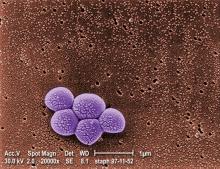VANCOUVER, B.C. – New compounds in preclinical stages of testing may eventually help combat the surge in methicillin-resistant Staphylococcus aureus and other multidrug resistant organisms, Dr. Ronald N. Jones said at the annual meeting of the Infectious Diseases Society of America.
Fusidic acid was discovered in the 1960s and used widely in Europe, Australia, and Canada. However because it was never released in the United States, domestic MRSA strains have built up little resistance to it, which makes it something of "an old drug in new clothing," said the chief executive officer of JMI Laboratories, a contract research organization in North Liberty, Iowa.
Dr. Jones and his colleagues tested the compound against 7,340 S. aureus isolates collected from 51 hospitals in every region of the country. Fusidic acid inhibited 99.6% of the isolates at a concentration of 1 mcg/mL or less. The compound also showed comparable activity against S. aureus strains in eight different resistance groups, including strains resistant to five or more other compounds including oxacillin, erythromycin, clindamycin, and the fluoroquinolones.
"This is pretty exciting, because it also has no cross-resistance with any other class of antibiotic," Dr. Jones said. "It could be used widely if we could deliver it in such a way that would prevent any emerging resistance from happening in what I call the naïve population of United States Staph aureus."
In addition, Dr. Jones said, "it's been conservatively stated that tens of millions of patients have been treated with fusidic acid over the period of the four-plus decades. The drug is considered safe, and it's usually administered orally for the treatment of serious staphylococcal infections. It also has been applied in some countries topically."
A second agent, JNJ-Q2, is a broad-spectrum fluoroquinolone developed by Johnson & Johnson and Furiex Pharmaceuticals.
"One of the things that was noted very early on is that quinolone resistance, particularly among methicillin-resistant staphylococci, became quite common over a decade ago," Dr. Jones said. "New compounds have been tried for a number of years, [but] what's novel about this is it’s 16 times more potent than the best of the existing marketed fluoroquinolones."
JNJ-Q2 is moving into phase II and phase III clinical trials. In preclinical studies, "We challenged it with the worst of the MRSA and the fluoroquinolone-resistant MRSA that we could find in our surveillance systems all around the planet. And this new compound came out quite well and covered essentially 90%-100% of the strains, depending upon the geography."
In comparison to other fluoroquinolones, JNJ-Q2 was 16 times more potent than moxifloxacin, 64 times more potent than levofloxacin, and 128 times more potent than ciprofloxacin when tested against 511 S. aureus isolates.
A third agent, ceftaroline, is a broad-spectrum cephalosporin from Forest Laboratories. It is being tested in combination with NXL104, a beta-lactamase inhibitor being developed by Novexel.
Dr. Jones pointed out that ceftaroline alone is active against MRSA and multidrug resistant pneumococci, but when combined with NXL104, it could also be used against the growing population of Enterobacteriaceae that produce derepressed AmpC beta-lactamase.
In studies, Dr. Jones and his colleagues determined that the combination, which they refer to as CXL104, inhibited 96% of ceftazidime-resistant strains of Enterobacter, Citrobacter, and Serratia at concentrations of 4 mcg/mL or lower.
"It's probably not going to be on the market until 2013 or 2014, [but will probably have labeling] against a large number of indications if everything goes well in clinical trials," Dr. Jones said.
The study on CXL104 was supported by Forest Laboratories, and the study on JNJ-Q2 was supported by Furiex Pharmaceuticals. JMI Laboratories conducts studies supported by Forest, Furiex, and other pharmaceutical companies.


